The Needle Fly
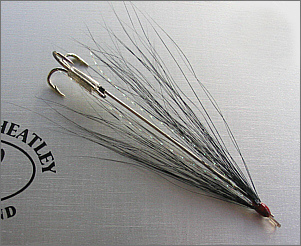
Picture the scene ..... a night in late July.
It's one a.m. and you are alone by a favourite fishing pool.
The river has gone quiet. You would be inclined to doubt
that there were any sea trout in the river if it weren't for
the brace of two pounders in the bass at your side. You tip
them out on to the grass for another look. They shine silver
in the moonlight, fresh from the tide. They were taken well
before midnight on a size 8 Butcher, fished on a floating
line. Since then, nothing. Time for a change, for something
bigger, to be fished deeper, perhaps on a slow sinking line.
Something long and slim and not too heavy.
A look in your fly boxes reveals a variety of
fishing lures, tied over the years for just this purpose. A
box of tube flies in all shapes, sizes and materials; a
selection of Waddingtons; rows of beautiful tandem lures,
sparsely dressed in the Falkus style; a few Marchogs with
their long trailing trebles. Each, in its own way,
ingenious. Each undoubtedly effective as a sea trout fishing
lure. Yet none of them quite perfect.
The
conventional tube fly, though simple in design, is not the
easiest thing to fit in a standard fly tying vice. It also
has a relatively bulky body, particularly the commercially
available plastic versions, while thinner plastic tubing has
a tendency to bend if used in longer lengths. Metal tubes,
e.g. aluminium, though thinner than the plastic, can cut
into the nylon leader if the internal plastic core is
damaged. In addition, I have always felt that the attachment
of the treble hook by means of a length of fairly thick
plastic tubing is too bulky to be entirely satisfactory. The
Waddington lure can be tied on various gauges and lengths of
wire but the attachment of the treble hook can be
problematical. The fly may have to be discarded, or, at the
very least, partially retied if the treble is damaged. Sunk
lures have the advantage of being very slim and well
balanced. However, whether tied using singles, doubles,
trebles or a combination, all involve considerable time and
care in their construction and, when damaged, will likely
have to be discarded.
[Note: the above paragraph was written
before the development of the Needle Tube]
I
sought, therefore, to devise a sea trout fishing lure which
would overcome the shortcomings of these earlier designs
while retaining some of their best features. Such a lure
would ideally have the following characteristics:
-
It
should be simple to construct, in a variety of sizes and
weights, using inexpensive and readily available
materials.
-
It
should be easy to attach to the line or to change at
night.
-
The
hook should be easily replaced if damaged, without the
loss of the lure itself.
-
It
should be generally light in weight, even in large
sizes, so that it can be easily cast and fished
effectively on both floating and sunk fly lines.
-
It
should have a slim profile to give the impression of a
small fish.
-
The
lure should always swim in line with the leader.
The
result, after much experimentation, was the
Needle
Fly.
As the name suggests, the
Needle Fly is simply a fly or, more accurately, a lure, tied
on a standard needle, in the same way as a tube fly is tied
on a tube. The second, and equally important, component is a
treble hook whose shank is covered by a tightly fitting
rubber or plastic sleeve which secures the point of the
needle during fishing. As with a tube fly, the leader is
tied directly to the treble hook and not to the "eye" of the
fly, which, in the case of the Needle Fly, is formed by a
small loop of strong nylon (e.g. 30 to 35 lbs monofilament).
Components and Construction
The Hook
|
For use with needles between one and two inches in
length, treble hooks ranging from size 16 to 10 are
most suitable, although doubles can also be used. To
adapt the treble hook, a sleeve of plastic or
rubber is fitted over the shank of the hook.
This sleeve will secure the point of the needle
while fishing. It is important, therefore, that the
sleeve is chosen carefully to match the diameter of
the hook shank. This sleeve must be strong and tight
fitting, with enough elasticity to grip the needle
firmly. If the sleeve fits loosely or is too soft,
the needle may slip out of the sleeve while casting.
|
|
|
|
Since my first experiments with the needle fly in
1998, I have tried all the kinds of tubing I could
lay my hands on. Early versions made use of the
plastic sleeving from electric cable. I then
experimented with heat shrink sleeves, neoprene
sleeves, carp rig tubing, silicone rubber and even
combinations of the above. None were entirely
satisfactory. The electric cable sleeving, like most
examples of the carp rig tubing, was a bit hard and
inflexible. The heat shrink was also a bit hard and
not very durable, even when used in double layers.
Silicone rubber, as used on floats, was too soft
and, although it is possible to buy silicone tubing
with a thicker wall, it does not grip the needle
well. Neoprene tubing was a bit bulky and available
in limited sizes. |
The most suitable type of tubing I have been able to find to
date is clear PVC tubing, as used for laboratory and medical
applications.
The most useful sizes I have tried are as follows:
PVC tubing, bore 1.0 mm/Wall 0.5mm (suitable for fine wire
treble hooks up to size 12)
PVC tubing, bore 1.5mm/wall 0.5mm ( suitable for size 10 and
8 treble hooks)
It is always worth experimenting with other types.
The Needle
The second component is
a needle,
adapted by the addition of :
a) a loop of strong nylon
(about 30 - 35 lbs b.s.) which forms the "eye" of the needle
fly. (Note that, as with a tube fly, the line is not tied to
this loop but to the treble hook itself).
b) a small stop of tying
thread (varnished) applied 1cm from the point of the needle.
This stop prevents the needle from slipping through the
sleeve while casting.
| |
|
Needle
with thread stop |
|
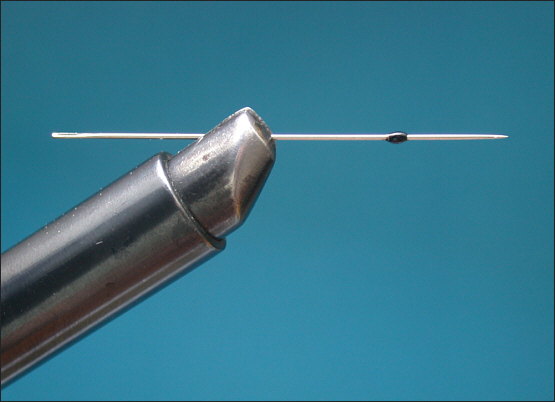 |
| |
|
Needle
with stop and nylon loop |
|
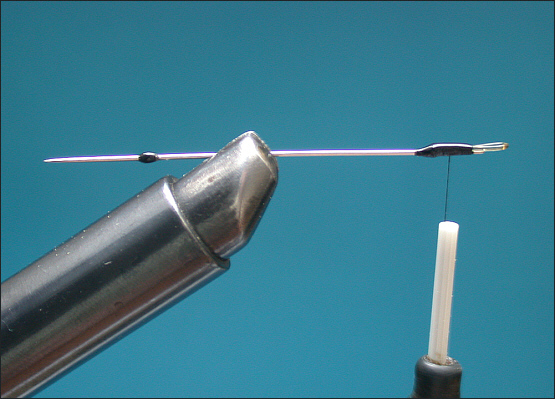 |
| |
|
A
simply dressed Needle |
|
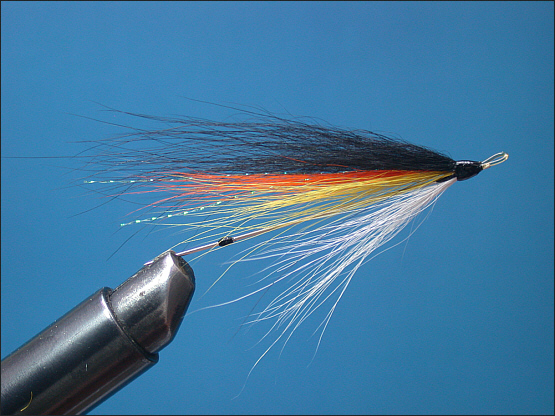 |
| |
|
Assembled Needle Fly |
|
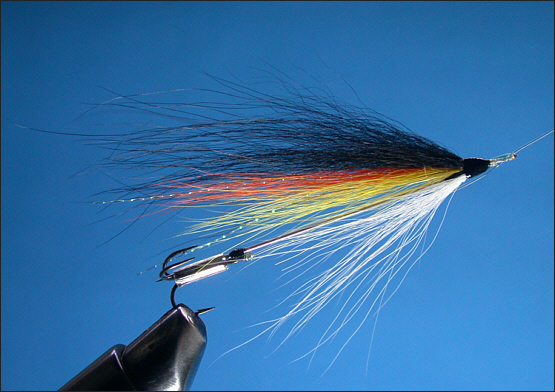 |
| |
|
For a
detailed Step by Step Tying Sequence see
Tying the Needle Fly |
Note that a needle is more easily inserted in the sleeve
than a straight piece of wire. A further benefit is that a
silver needle needs no body dressing. Needles are available
in a great variety of lengths and weights. I have found the
most useful are those described as "Betweens",
"Sharps" and "Long Darners".
The gauge, or thickness, of the needle is described by a
number and for any given number, the Betweens are the
shortest, followed by the Sharps, while the Long Darners are
the longest. We can think of Betweens as "short
Shank needles", Sharps as "standard
shank needles" and Long Darners
as "long shank needles". The table below
shows the relative gauges and lengths of the three types:
NEEDLE TYPES AND SIZES
|
TYPE |
SIZE |
DIAMETER |
LENGTH |
|
BETWEEN |
6 |
0.027 inches |
0.69 mms |
1¼ inches |
|
SHARP |
6 |
0.027 inches |
0.69 mms |
1½ inches |
|
LONG DARNER |
9 |
0.024 inches |
0.61 mms |
2 inches |
|
LONG DARNER |
7 |
0.027 inches |
0.69 mms |
2¼ inches |
Using the Needle Fly
To attach the Needle Fly to the fly leader, simply thread a
Needle Fly on to the leader (as you would a tube), tie on a
suitable size treble hook (complete with rubber/plastic
sleeve) then insert the needle firmly into the sleeve until
the thread stop on the needle touches the sleeve. Fix the
needle on the top of the treble hook with the leader lying
along the underside of the needle.
|
SAFETY
Fishing hooks and needles may cause injury.
The construction of the Needle Fly, as in all
fly tying, involves the risk of minor injuries
from hook and needle points etc.
It is essential that you wear a safe and
effective form of eye protection, such as safety
glasses, when handling and using needles and
fishing hooks, as needles and some hooks are
brittle and may break when bent.
It is also important to wear effective head and
eye protection when fly fishing.
|
I would say, in conclusion, that the most crucial component
of the needle fly is the tubing used for the treble sleeve.
It should be strong and durable but with enough
flexibility/elasticity to grip the needle firmly. It is most
important, in construction, to match the diameter and wall
thickness of the tubing to an appropriate size and weight of
treble hook, both of which must then be matched to an
appropriate length and diameter of needle. For example,
let's say you begin with a size 8 treble made from a heavy
wire. A narrow tube with a diameter of 1mm will not fit over
the eye of the hook. You will need tubing with a 1.5mm bore.
If you begin with a fine wire size 14 treble, the 1.5 mm
bore tubing will be much too large. But even when you have
found a type and size of tubing to match the size and weight
of the treble hook, you must also match this to a needle of
appropriate diameter. A very thick needle will be difficult
to insert in the sleeve and will possibly overstretch the
sleeve. Too thin a needle might not be gripped firmly enough
by the sleeve.
I have found that the needle fly is at its best, as a lure
for sea trout, in lengths between 1.25 inches and 2 inches.
Needles are available in different gauges. The finest are
labelled Sharps, while the slightly heavier gauge are
called Betweens. By using the two types, it is possible to
vary the weight of the fly.
In tying your own needle flies, I would recommend you start
with a Sharp needle of around 1.5 inches long and match it
to a size 12 fine wire treble
hook, with a smooth medium length shank, matched to a
suitable sleeve with a bore of around 1mm. You can
experiment from there. For those who find the components
difficult to get hold of, a
needle fly kit
is now available. I had at first hoped that I might get away
with a simple needle, held in place on the treble by a
tightly fitting sleeve. However, in order to prevent the
needle slipping through the sleeve when casting (when it is
subject to enormous force), I decided I needed a stop of
some kind, fixed on to the needle. I have tried blobs of
glue, short lengths of very fine heat shrink etc. but have
now settled on a small but tight wrapping of tying thread
coated with a drop of varnish. Do not tie the stop too near
the end of the needle. To ensure a good grip, the point of
the needle should, when assembled, be at the rear end of the
sleeve or even protruding slightly. For this same reason, it
is unwise to use a treble hook with too short a shank.
My fishing diary of 1999
records that, in eighteen hours of night fly fishing on the
Crieff Angling Club stretch of the River Earn, between 25th
June and 7th July, I had seven sea trout, the
Needle Fly accounting for six of these, weighing between two
pounds and four and a half pounds. Since its early successes
on the River Earn, the Needle Fly, and the more recently
developed
needle tube fly, have become my favourite fishing lures
for late night sea trout. It is also useful earlier in the
night when the river is running a bit high or cold,
particularly in early season and, in addition, it has
accounted for a few salmon.
I have to thank the editor of
Trout and Salmon magazine for his permission to use extracts
from my article "Needles for Sewin", which appeared in the
September 1999 issue of that esteemed publication.
Sea Trout Articles |
|